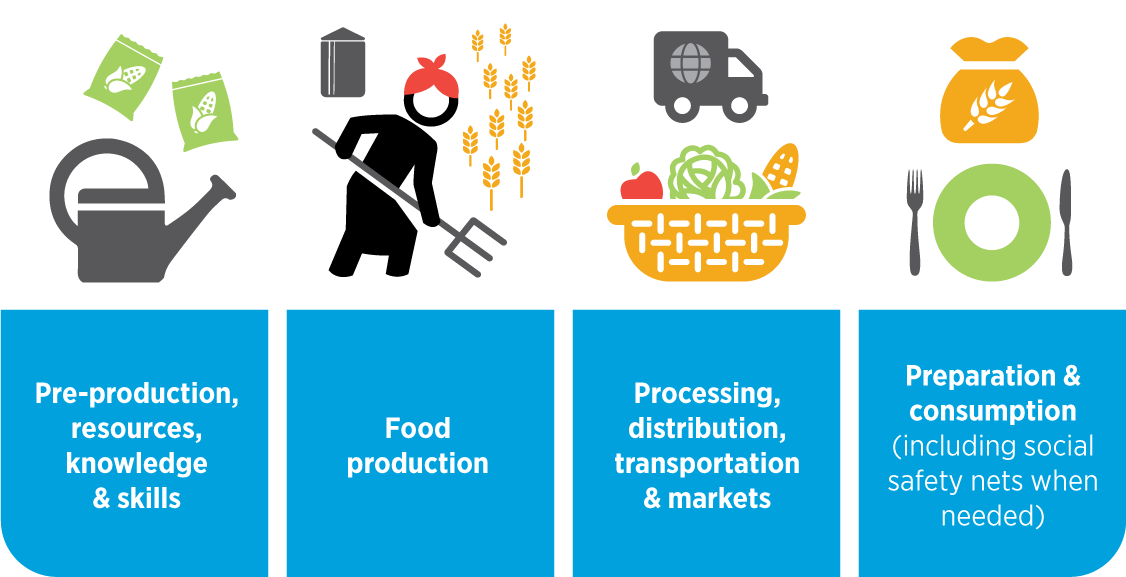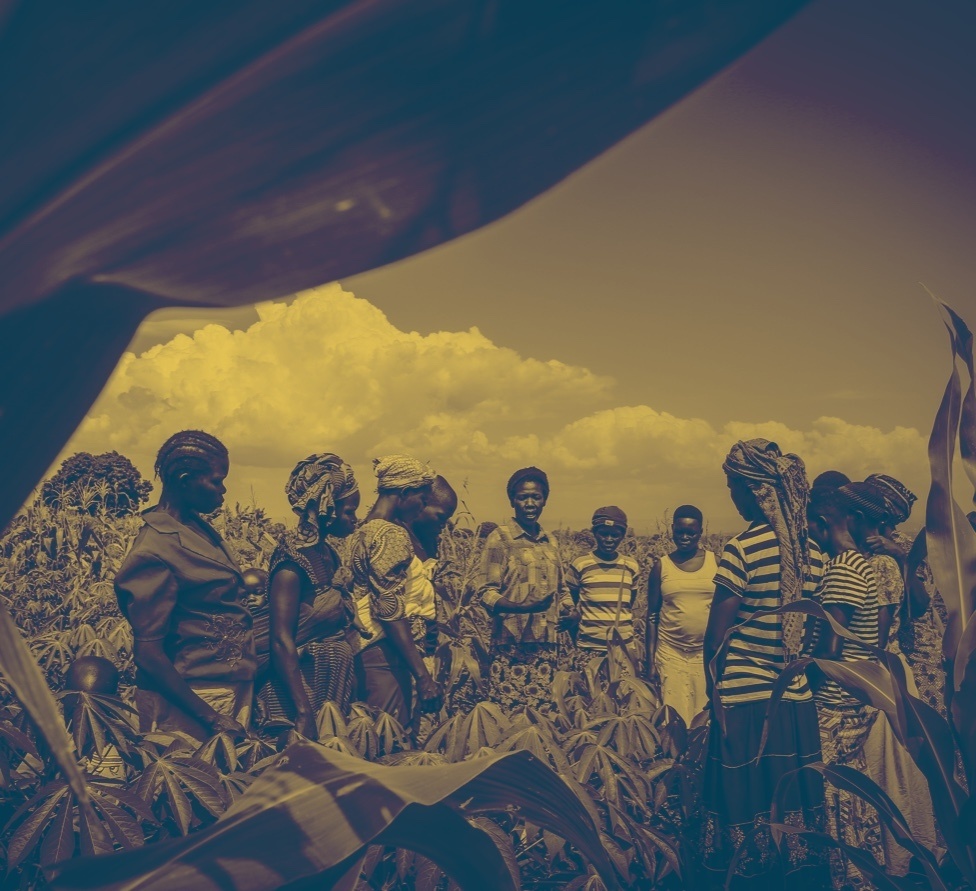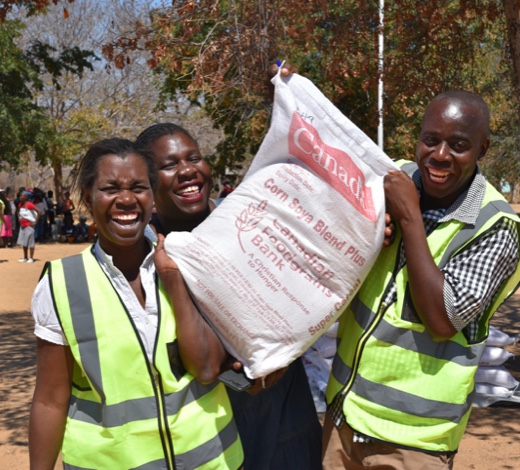Canadian Aid Makes a Difference
A more resilient food system is one in which individuals and households are able to cope with shocks, adapt to change and transform away from unsustainable ways of living. For example, shifting from cutting down trees to sell as firewood to make a living, to planting trees to enhance agricultural productivity. It’s not about just getting back to where things were before after a shock—but making sure we’re in a much better place.
Working towards a more resilient food system requires a deep understanding of specific environmental, social, cultural, economic and historical contexts. It requires examining challenges from multiple angles, seeking to understand interconnections and the consequences of specific responses. A food systems approach to building resilience is a complex solution to a complex problem.

THE PROBLEM
The current global food system doesn’t meet the needs of most people or our planet.
- Around 1.23 billion people work in the global food system, and almost half the world’s population live in households linked to agrifood systems. Yet, it fails to provide most of these people with a decent livelihood.
- Food insecurity is rising globally. It is estimated that between 691 and 783 million people experienced regular hunger in 2022. Considering the midrange (about 735 million), 122 million more people faced hunger in 2022 than in 2019, before the global pandemic.
- The most likely to be hungry are rural African women.
- Persistent gender inequality means less support and opportunity for women who farm, and discrimination for women and girls across the food system, including in accessing adequate diets. The prevalence of moderate or severe food insecurity was 2.4% higher among women than men in 2022.
- Globally, food insecurity is higher in rural areas than in peri-urban or urban areas.
- About 20% of people in African are food insecure, compared to 9% of people in Asia, 6% in Latin America and lower levels elsewhere.
- Food systems are both harmed by climate change and a major cause of it. The world’s food system is responsible for approximately one third of global greenhouse gas emissions which cause climate change. Approximately half of these (17% of all emissions) are attributed to agriculture. However, the agricultural sector in low- and middle-income countries is disproportionately affected by climate change, suffering 63% of the damages and losses from natural disasters between 2008 and 2018.
- Furthermore, food systems are sensitive to conflict. In fact, it is the major driver of global hunger today. Many of those who flee from the conflict quickly run out of money to buy food. Those who stay are not able to move around to make money, tend to farms, or buy food. Widespread violence shuts down markets and destroys infrastructure. Additionally, conflict in one part of the world can contribute to hunger in other places, such as with the war in Ukraine, which has prevented the export of both food and fertilizer to countries in Africa and Asia.
AN OPPORTUNITY
At the G7 Summit in June 2021, Canada committed to double its international climate finance, to $5.3 billion over the next five years, including increased support for adaptation, as well as nature and nature-based solutions. Canada has also made global commitments on addressing biodiversity loss, enabling gender equality and helping to end hunger.
Canada can meet multiple global goals through a sustainable long-term response to the global food and climate crisis.
The Government of Canada should:
Take leadership in responding to the global food and climate crisis by increasing investments in resilient food systems in the Global South.
To ensure greatest impact, investments should support:
- Nature-based solutions. Conservation agriculture, agroforestry and other agriculture nature-based solutions can increase agricultural production, support food security, fight climate change and enhance nature and biodiversity.
- Gender equality. Women should be leaders and participants in all areas of the food system. Through farm organizations they should help shape food system policies and be powerful change agents in building climate resilient food systems.
In addition, funding for diversity in crop varieties, livestock breeds, and livelihoods will help spread risk and support resilience. More learning and innovation, including strong farmer organizations, particularly women’s groups, will do the same. And nexus programming that links disaster responses to long-term development will provide a pathway from crises to sustainable livelihoods.
These investments would address one of the most pressing challenges of our time: ensuring all people can access healthy and nutritious diets while sustaining and strengthening our natural environment. They would contribute to a secure, just and equitable world.
WHY DOES CANADIAN FOODGRAINS BANK CARE?
Canadian Foodgrains Bank is a partnership of Canadian churches and church-based agencies working to end global hunger. The impacts of climate change, biodiversity loss, and other challenges are making it harder for small-scale farmers to provide food for their families and communities. We also know through the agriculture and livelihood projects we support that enabling farmers to adapt to climate change can have multiple benefits: increased food security, more household income, better resilience to disasters, and a more hopeful future.
WHAT CAN YOU DO RIGHT NOW?
You can join others in speaking out for our global neighbors by building your own personalized letter to the Minister of Finance, and the Minister of International Development. This is a quick and meaningful action you can take that can make a big difference!


Did You Know?
- The aid Canada provides is helping end global hunger and poverty. It can create opportunities for women and men to grow enough food for themselves and their families in a sustainable way and contribute to prosperous local economies, increasing self-reliance now and into the future.
- Canadian aid includes emergency assistance after natural disasters, educational programs, health support, clean water and sanitation, climate change adaptation, food assistance and agricultural support to developing countries. Canadian aid can be funnelled through multiple channels, including organizations such as the Foodgrains Bank, who work with local partners in developing countries to support those in need.
Canadian aid makes a difference!
FAQs
-
Why is aid important?
Aid, or ODA (Official Development Assistance), plays a central role in addressing global hunger and poverty. The aid from donor countries provides immediate assistance in times of crises, and includes investments in health, education, and economic opportunities for people who are poor or marginalized, especially women. Aid helps strengthen local governments to better serve the needs of their citizens. And aid empowers people in developing countries to speak up, tell their governments what they need and hold them accountable.
While aid is not the only tool that helps achieve these goals, it is the only tool with the primary objective of reducing global poverty.
Aid can help developing countries become more prosperous, reducing the risk of conflicts. It also helps communities become better prepared for natural disasters and a changing climate, reducing the need for humanitarian assistance and costly disaster responses.
-
Don’t we already give a lot?
Canada commits roughly $5 billion every year towards addressing poverty and inequality around the world. This is a large sum of money, but is only 1.7% of Canada’s budget and a small portion of Canada’s Gross National Income (GNI) at just 0.26%. Put another way, for every $100 that Canada earns as income, roughly 26 cents are given back to address global poverty. This is compared to an average 0.52% given by peer countries (France, Italy, USA, Germany, UK, Japan, Australia, Switzerland, Netherlands, Norway, and Sweden) and a globally agreed target of 0.7%.
-
Shouldn't we fix things here in Canada first?
We need to do both. The challenges of poverty, inequality, and hunger also exist here in our own back yard. The federal government has a responsibility to address the wellbeing of its citizens. Canada is also part of a global community, where we impact the wellbeing of those on the other side of the world now more than ever.
Canada can address global challenges while also addressing challenges here at home. We don’t need to wait until all of Canada’s problems are solved before we help those facing hunger, poverty and inequality in other parts of our world. Nor would cutting international aid suddenly solve our domestic problems.
Issues such as climate change, peace security don’t have borders. Ignoring them may have a negative impact on us here at home. We cannot benefit by solving these issues in Canada alone. Global issues require global solutions.
-
With federal budget deficits, can Canada afford to give more?
Government departments must make tough decisions when balancing a range of priorities and funding requests for multiple federal programs, including aid. This is also true in other countries, including countries that provide international aid. Even with this wide range of priorities, countries with similar economies manage to give, on average, twice as much aid as Canada. As Canadians, we have the right and opportunity to inform government as to how we believe Canada should spend its limited resources.
We believe Canada can keep up with its peers, do its fair share, and dare to be leaders when it comes to providing aid that addresses global poverty.
-
Can’t we just give aid more effectively instead of adding more?
Canada continues to improve the effectiveness of its aid program. Organizations, such as Canadian Foodgrains Bank, help Canada make its aid more effective at ending global hunger and poverty by sharing evidence and best practices, such as ensuring local communities are involved in decision-making.
The amount we give is also important. Global needs are great, and we can only be so effective with limited resources. Increasing aid will enable us to reach more people.
-
Shouldn’t we focus on domestic problems instead?
The challenges of poverty, inequality, and hunger also exist here in Canada, and the federal government has a responsibility to address the wellbeing of its citizens.
At the same time, Canada is part of a global community and the issues we grapple with at a global level touch lives in Canada too. We can address global challenges while also addressing problems here at home. We don’t need to wait until all of Canada’s problems are solved before we help those facing hunger, poverty, and inequality in other parts of our world.
-
Doesn’t aid just get wasted? How does Canada ensure money doesn’t end up in the hands of corrupt governments?
Aid dollars are needed in some of the most conflicted and instable places in the world. Despite best efforts, it’s not always possible to ensure that all aid dollars get used efficiently and effectively.
That said, the Canadian government has committed to global accountability and transparency standards in its aid. It has taken steps to ensure aid dollars are used effectively, and that Canadians can track how aid dollars are being spent.
Furthermore, there’s lots of evidence showing the positive impacts of aid on development and raising standards of living.
-
Doesn’t aid create dependence? Why can’t people help themselves?
It’s true that aid given poorly can increase the dependence on aid by countries or communities. But it’s also true that some of the world’s poorest countries are now far less reliant on aid than 10-15 years ago. Aid that creates opportunities for women and men to grow enough food to feed themselves and their families in a sustainable way and contribute to prosperous local economies can increase self-reliance now and into the future.
By working closely with Canadian development organizations and local partner organizations, who strive for sustainability and community involvement in decision-making, Canadian aid can build capacity and foster independence.
-
What could be supported with a larger aid budget?
The Foodgrains Bank, along with many other organizations and researchers, have advocated for increased investments in agriculture, especially for small-scale farmers.
Canada has an ambitious new international assistance policy, with important goals around empowering women and improving women’s equality as an important pathway to reducing poverty and hunger around the world. It has also made global commitments toward reaching the Sustainable Development Goals. To meet these goals and commitments, more resources will be needed.
Investments in agricultural development are an important way Canada can improve the lives of those living in poverty, especially women. Canada’s investments can empower women to better access farming resources, strengthen farmers’ voices (including through farmer cooperatives and women’s organizations), and enable agricultural innovation. There is lots of evidence showing how investments in agriculture increases economic growth, improves nutrition, and helps communities adapt to a changing climate.
-
Are you asking for more money for Foodgrains Bank?
No, we’re not specifically asking for more money for Canadian Foodgrains Bank. We are thankful for ongoing support from the Canadian government to the Foodgrains Bank for its work in ending global hunger. But this is a big goal. We need the Canadian government to increase the aid budget to help make this goal a reality.
-
How will this benefit Canadians?
As Canadians, we care about helping others even when it may not directly benefit us. Canadian Foodgrains Bank strives to see an end to global hunger. We believe many Canadians feel the same way. We value compassion and want our government to be generous too.
We also believe that in helping to end global poverty we can create a more prosperous, fairer and hopeful world. This is good for all of us. It means more global security, a stronger global economy and more trade and investment opportunities for Canadians. It also reduces costs for responding to disasters and famines in the future.
-
Why is it my role to advocate?
We are fortunate to live in a country where we can use our voices to work towards justice around the world. As such, we have an opportunity to speak for those who are not so fortunate; whose identity, status, or political structures do not allow their voices to be heard.
There is also a clear Biblical basis for advocacy. Advocacy is using your voice to speak in support of another. When it comes to hunger, poverty, and inequality, these are often matters of justice, compassion, and healing relationships with other people. The Bible is filled with examples of advocates, such as Esther, Moses, and Jesus.
In Canada’s democratic system, it is important that the government’s choices represent constituents’ views (including yours!). Canada’s support for aid is decided by the federal government, including your Member of Parliament. To ensure your MP knows this issue is important to you, you can:
- Sign a postcard
- Use social media to demonstrate your support, #MoreCanada, #MoreAid4Ag
- Write a letter to your MP, or the Minister for International Development
- Phone your MP
- Meet with your MP directly
-
Does signing a postcard make a difference?
Yes! Government officials have noted public support is a critical component if we want to increase the aid budget. The government has affirmed efforts by the Foodgrains Bank to raise public awareness and provide opportunities for Canadians to show their support for these issues. Postcards and other public demonstrations of support are noticed by policymakers, and have encouraged Canada to remain focused on addressing global hunger over the years. Your postcard amplifies the message of thousands like you who are showing they care.